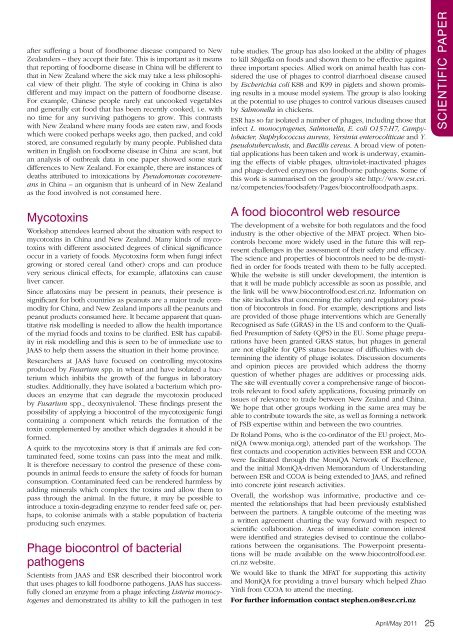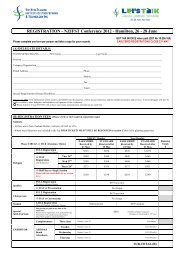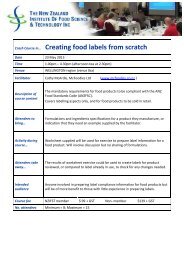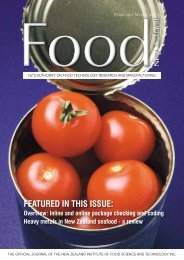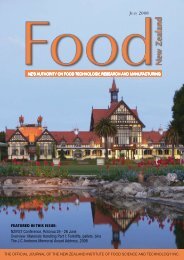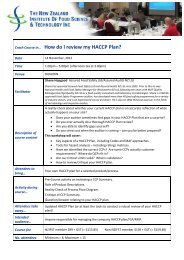featured in this issue - NZIFST - The New Zealand Institute of Food ...
featured in this issue - NZIFST - The New Zealand Institute of Food ...
featured in this issue - NZIFST - The New Zealand Institute of Food ...
Create successful ePaper yourself
Turn your PDF publications into a flip-book with our unique Google optimized e-Paper software.
after suffer<strong>in</strong>g a bout <strong>of</strong> foodborne disease compared to <strong>New</strong><br />
<strong>Zealand</strong>ers – they accept their fate. This is important as it means<br />
that report<strong>in</strong>g <strong>of</strong> foodborne disease <strong>in</strong> Ch<strong>in</strong>a will be different to<br />
that <strong>in</strong> <strong>New</strong> <strong>Zealand</strong> where the sick may take a less philosophical<br />
view <strong>of</strong> their plight. <strong>The</strong> style <strong>of</strong> cook<strong>in</strong>g <strong>in</strong> Ch<strong>in</strong>a is also<br />
different and may impact on the pattern <strong>of</strong> foodborne disease.<br />
For example, Ch<strong>in</strong>ese people rarely eat uncooked vegetables<br />
and generally eat food that has been recently cooked, i.e. with<br />
no time for any surviv<strong>in</strong>g pathogens to grow. This contrasts<br />
with <strong>New</strong> <strong>Zealand</strong> where many foods are eaten raw, and foods<br />
which were cooked perhaps weeks ago, then packed, and cold<br />
stored, are consumed regularly by many people. Published data<br />
written <strong>in</strong> English on foodborne disease <strong>in</strong> Ch<strong>in</strong>a are scant, but<br />
an analysis <strong>of</strong> outbreak data <strong>in</strong> one paper showed some stark<br />
differences to <strong>New</strong> <strong>Zealand</strong>. For example, there are <strong>in</strong>stances <strong>of</strong><br />
deaths attributed to <strong>in</strong>toxications by Pseudomonas cocovenenans<br />
<strong>in</strong> Ch<strong>in</strong>a – an organism that is unheard <strong>of</strong> <strong>in</strong> <strong>New</strong> <strong>Zealand</strong><br />
as the food <strong>in</strong>volved is not consumed here.<br />
tube studies. <strong>The</strong> group has also looked at the ability <strong>of</strong> phages<br />
to kill Shigella on foods and shown them to be effective aga<strong>in</strong>st<br />
three important species. Allied work on animal health has considered<br />
the use <strong>of</strong> phages to control diarrhoeal disease caused<br />
by Escherichia coli K88 and K99 <strong>in</strong> piglets and shown promis<strong>in</strong>g<br />
results <strong>in</strong> a mouse model system. <strong>The</strong> group is also look<strong>in</strong>g<br />
at the potential to use phages to control various diseases caused<br />
by Salmonella <strong>in</strong> chickens.<br />
ESR has so far isolated a number <strong>of</strong> phages, <strong>in</strong>clud<strong>in</strong>g those that<br />
<strong>in</strong>fect L. monocytogenes, Salmonella, E. coli O157:H7, Campylobacter,<br />
Staphylococcus aureus, Yers<strong>in</strong>ia enterocoliticae and Y.<br />
pseudotuberculosis, and Bacillis cereus. A broad view <strong>of</strong> potential<br />
applications has been taken and work is underway, exam<strong>in</strong><strong>in</strong>g<br />
the effects <strong>of</strong> viable phages, ultraviolet-<strong>in</strong>activated phages<br />
and phage-derived enzymes on foodborne pathogens. Some <strong>of</strong><br />
<strong>this</strong> work is summarised on the group’s site http://www.esr.cri.<br />
nz/competencies/foodsafety/Pages/biocontrolfoodpath.aspx.<br />
Scientific Paper<br />
Mycotox<strong>in</strong>s<br />
Workshop attendees learned about the situation with respect to<br />
mycotox<strong>in</strong>s <strong>in</strong> Ch<strong>in</strong>a and <strong>New</strong> <strong>Zealand</strong>. Many k<strong>in</strong>ds <strong>of</strong> mycotox<strong>in</strong>s<br />
with different associated degrees <strong>of</strong> cl<strong>in</strong>ical significance<br />
occur <strong>in</strong> a variety <strong>of</strong> foods. Mycotox<strong>in</strong>s form when fungi <strong>in</strong>fect<br />
grow<strong>in</strong>g or stored cereal (and other) crops and can produce<br />
very serious cl<strong>in</strong>ical effects, for example, aflatox<strong>in</strong>s can cause<br />
liver cancer.<br />
S<strong>in</strong>ce aflatox<strong>in</strong>s may be present <strong>in</strong> peanuts, their presence is<br />
significant for both countries as peanuts are a major trade commodity<br />
for Ch<strong>in</strong>a, and <strong>New</strong> <strong>Zealand</strong> imports all the peanuts and<br />
peanut products consumed here. It became apparent that quantitative<br />
risk modell<strong>in</strong>g is needed to allow the health importance<br />
<strong>of</strong> the myriad foods and tox<strong>in</strong>s to be clarified. ESR has capability<br />
<strong>in</strong> risk modell<strong>in</strong>g and <strong>this</strong> is seen to be <strong>of</strong> immediate use to<br />
JAAS to help them assess the situation <strong>in</strong> their home prov<strong>in</strong>ce.<br />
Researchers at JAAS have focused on controll<strong>in</strong>g mycotox<strong>in</strong>s<br />
produced by Fusarium spp. <strong>in</strong> wheat and have isolated a bacterium<br />
which <strong>in</strong>hibits the growth <strong>of</strong> the fungus <strong>in</strong> laboratory<br />
studies. Additionally, they have isolated a bacterium which produces<br />
an enzyme that can degrade the mycotox<strong>in</strong> produced<br />
by Fusarium spp., deoxynivalenol. <strong>The</strong>se f<strong>in</strong>d<strong>in</strong>gs present the<br />
possibility <strong>of</strong> apply<strong>in</strong>g a biocontrol <strong>of</strong> the mycotoxigenic fungi<br />
conta<strong>in</strong><strong>in</strong>g a component which retards the formation <strong>of</strong> the<br />
tox<strong>in</strong> complemented by another which degrades it should it be<br />
formed.<br />
A quirk to the mycotox<strong>in</strong>s story is that if animals are fed contam<strong>in</strong>ated<br />
feed, some tox<strong>in</strong>s can pass <strong>in</strong>to the meat and milk.<br />
It is therefore necessary to control the presence <strong>of</strong> these compounds<br />
<strong>in</strong> animal feeds to ensure the safety <strong>of</strong> foods for human<br />
consumption. Contam<strong>in</strong>ated feed can be rendered harmless by<br />
add<strong>in</strong>g m<strong>in</strong>erals which complex the tox<strong>in</strong>s and allow them to<br />
pass through the animal. In the future, it may be possible to<br />
<strong>in</strong>troduce a tox<strong>in</strong>-degrad<strong>in</strong>g enzyme to render feed safe or, perhaps,<br />
to colonise animals with a stable population <strong>of</strong> bacteria<br />
produc<strong>in</strong>g such enzymes.<br />
Phage biocontrol <strong>of</strong> bacterial<br />
pathogens<br />
Scientists from JAAS and ESR described their biocontrol work<br />
that uses phages to kill foodborne pathogens. JAAS has successfully<br />
cloned an enzyme from a phage <strong>in</strong>fect<strong>in</strong>g Listeria monocytogenes<br />
and demonstrated its ability to kill the pathogen <strong>in</strong> test<br />
A food biocontrol web resource<br />
<strong>The</strong> development <strong>of</strong> a website for both regulators and the food<br />
<strong>in</strong>dustry is the other objective <strong>of</strong> the MFAT project. When biocontrols<br />
become more widely used <strong>in</strong> the future <strong>this</strong> will represent<br />
challenges <strong>in</strong> the assessment <strong>of</strong> their safety and efficacy.<br />
<strong>The</strong> science and properties <strong>of</strong> biocontrols need to be de-mystified<br />
<strong>in</strong> order for foods treated with them to be fully accepted.<br />
While the website is still under development, the <strong>in</strong>tention is<br />
that it will be made publicly accessible as soon as possible, and<br />
the l<strong>in</strong>k will be www.biocontrolfood.esr.cri.nz. Information on<br />
the site <strong>in</strong>cludes that concern<strong>in</strong>g the safety and regulatory position<br />
<strong>of</strong> biocontrols <strong>in</strong> food. For example, descriptions and lists<br />
are provided <strong>of</strong> those phage <strong>in</strong>terventions which are Generally<br />
Recognised as Safe (GRAS) <strong>in</strong> the US and conform to the Qualified<br />
Presumption <strong>of</strong> Safety (QPS) <strong>in</strong> the EU. Some phage preparations<br />
have been granted GRAS status, but phages <strong>in</strong> general<br />
are not eligible for QPS status because <strong>of</strong> difficulties with determ<strong>in</strong><strong>in</strong>g<br />
the identity <strong>of</strong> phage isolates. Discussion documents<br />
and op<strong>in</strong>ion pieces are provided which address the thorny<br />
question <strong>of</strong> whether phages are additives or process<strong>in</strong>g aids.<br />
<strong>The</strong> site will eventually cover a comprehensive range <strong>of</strong> biocontrols<br />
relevant to food safety applications, focus<strong>in</strong>g primarily on<br />
<strong>issue</strong>s <strong>of</strong> relevance to trade between <strong>New</strong> <strong>Zealand</strong> and Ch<strong>in</strong>a.<br />
We hope that other groups work<strong>in</strong>g <strong>in</strong> the same area may be<br />
able to contribute towards the site, as well as form<strong>in</strong>g a network<br />
<strong>of</strong> FSB expertise with<strong>in</strong> and between the two countries.<br />
Dr Roland Poms, who is the co-ord<strong>in</strong>ator <strong>of</strong> the EU project, MoniQA<br />
(www.moniqa.org), attended part <strong>of</strong> the workshop. <strong>The</strong><br />
first contacts and cooperation activities between ESR and CCOA<br />
were facilitated through the MoniQA Network <strong>of</strong> Excellence,<br />
and the <strong>in</strong>itial MoniQA-driven Memorandum <strong>of</strong> Understand<strong>in</strong>g<br />
between ESR and CCOA is be<strong>in</strong>g extended to JAAS, and ref<strong>in</strong>ed<br />
<strong>in</strong>to concrete jo<strong>in</strong>t research activities.<br />
Overall, the workshop was <strong>in</strong>formative, productive and cemented<br />
the relationships that had been previously established<br />
between the partners. A tangible outcome <strong>of</strong> the meet<strong>in</strong>g was<br />
a written agreement chart<strong>in</strong>g the way forward with respect to<br />
scientific collaboration. Areas <strong>of</strong> immediate common <strong>in</strong>terest<br />
were identified and strategies devised to cont<strong>in</strong>ue the collaborations<br />
between the organisations. <strong>The</strong> Powerpo<strong>in</strong>t presentations<br />
will be made available on the www.biocontrolfood.esr.<br />
cri.nz website.<br />
We would like to thank the MFAT for support<strong>in</strong>g <strong>this</strong> activity<br />
and MoniQA for provid<strong>in</strong>g a travel bursary which helped Zhao<br />
Y<strong>in</strong>li from CCOA to attend the meet<strong>in</strong>g.<br />
For further <strong>in</strong>formation contact stephen.on@esr.cri.nz<br />
April/May 2011<br />
25


